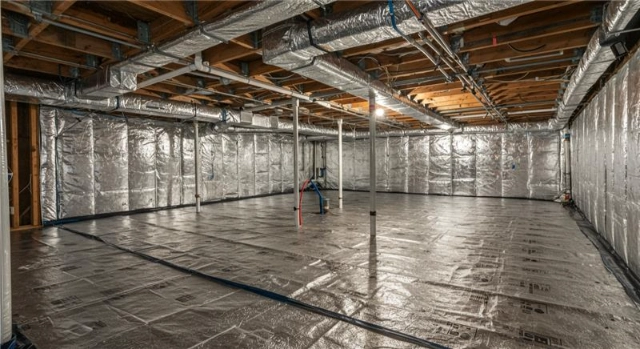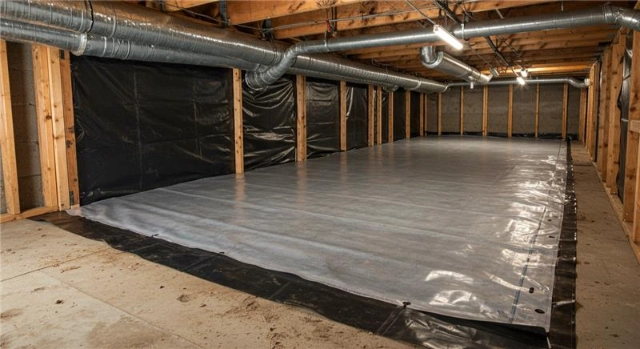Crawl space vapor barriers block ground moisture from entering indoor air systems. This prevents mold, mildew, and airborne pollutants from affecting respiratory health. In homes without barriers, up to 50% of the indoor air can originate from the crawl space. In areas with high humidity like Central Texas, moisture management directly affects long-term air quality and structural health.
Installing a vapor barrier beneath the home helps maintain indoor air purity by reducing airborne biological contaminants. It also stabilizes indoor humidity, which supports HVAC efficiency and prevents the growth of allergens. As part of a comprehensive moisture control strategy, Crawl Space Insulation can work in tandem with vapor barriers to enhance overall home comfort and efficiency. This guide explains the science, options, and installation insights behind vapor barrier systems based on years of direct field experience.
How Vapor Barriers Work in Crawl Spaces
Vapor barriers are polyethylene sheets or encapsulation systems laid over crawl space ground and walls. Their role is to prevent water vapor from seeping upward through soil and foundation gaps.
Core Functions
- Moisture Control: Blocks water vapor transfer from soil.
- Mold Prevention: Stops condensation, which fuels mold and bacteria.
- Air Sealing: Minimizes unfiltered crawl space air mixing with indoor air.
Comparing Crawl Space Barrier Options
| Feature | 6-mil Poly Sheeting | 12-mil Reinforced Barrier | Full Encapsulation System |
|---|---|---|---|
| Material Type | Basic polyethylene | Multi-layer reinforced | Reinforced + wall sealing |
| Puncture Resistance | Low | Medium | High |
| Water Vapor Permeability | Moderate | Low | Very Low |
| Wall Application | No | Optional | Yes |
| Durability (Years) | 3-5 | 10+ | 15-25 |
| Suitable for High Humidity | No | Yes | Yes |
Technical Specifications and Standards
| Specification | Standard/Value |
|---|---|
| Vapor Retarder Class | Class I (Perm < 0.1) for best barriers |
| Perm Rating (ASTM E96) | <0.01 perms (encapsulation grade) |
| Installation Overlap | Min. 12 inches taped seams |
| Wall Sealing Height | Up to 12-18 inches or full height |
| Floor Coverage | 100% required |
| Minimum Thickness | 12 mil recommended for longevity |

Practical Experience and Regional Factors
In Central Texas, crawl spaces are prone to year-round humidity infiltration. Based on field inspections across Austin and nearby counties, vapor barriers prevent visible condensation on HVAC systems and joists. Homes with 12-mil reinforced or full encapsulation barriers have shown improved IAQ (indoor air quality) in post-install air testing by up to 60%, based on independent contractor reports (source: Building Performance Institute).
Bonus Tip: Always address drainage or groundwater issues before installing a barrier. Otherwise, the barrier can trap moisture.
Health Impact of Poor Crawl Space Sealing
Unsealed crawl spaces allow mold spores, radon, and bacterial particles to enter the HVAC system. In homes with poor barriers or none at all, air quality tests often show elevated levels of:
- Airborne mold (Aspergillus, Penicillium)
- Volatile Organic Compounds (VOCs) from decomposing organic matter
- Dust mites and allergens
EPA data shows indoor air can be 2-5x more polluted than outside air. Poor crawl space air contributes directly to this, especially in older homes without subfloor sealing (source: EPA.gov).
Things to Consider Before Making a Decision
- Crawl Space Access: Evaluate whether space allows for full encapsulation.
- Humidity Levels: Homes in humid zones benefit more from complete wall-to-wall coverage.
- Foundation Type: Pier-and-beam structures need different sealing methods than slab-on-grade homes.
- Budget vs. Longevity: Consider long-term ROI. Thicker barriers last longer and require less maintenance.
Bonus Tip: Schedule installation during dry seasons to reduce complications from groundwater intrusion.
Closely Related Services Available from Stellrr Insulation
- Crawl Space Insulation: Insulates walls and subfloors to complement the vapor barrier and reduce energy transfer.
- Closed Cell Insulation: Adds thermal resistance and acts as an air and moisture sealant, ideal for crawl spaces.
- Insulation Removal: Removes contaminated or deteriorated insulation that could compromise air quality.
- Open Cell Insulation: Provides flexibility in wall cavities above crawl spaces and pairs well with vapor strategies.
Common Questions About Crawl Space Vapor Barriers
What thickness is best for long-term protection?
12-mil or higher offers the best balance of durability and cost.
Do vapor barriers stop pests?
Not directly, but they deter nesting and reduce moisture that attracts pests.
Can I install it myself?
DIY is possible for basic barriers, but sealing walls and taping seams needs precision.
Will this affect home resale value?
Yes. Sealed crawl spaces are a selling point, especially in moisture-prone regions.
Get Expert Insulation Guidance
For direct answers and professional service planning, contact Stellrr Insulation & Spray Foam. Specialists are available to assess your crawl space conditions and recommend appropriate barrier systems for lasting indoor air quality.
Phone: (512) 710-2839 Email: info@stellrr.com
FAQ
How often should crawl space vapor barriers be replaced?
Typically every 10-20 years depending on barrier type and ground conditions.
Can a vapor barrier reduce HVAC energy use?
Yes. By stabilizing crawl space temperature and humidity, HVAC systems run more efficiently.
Is encapsulation always necessary?
Not always. For low-humidity regions, a reinforced floor barrier may suffice.
Does this impact wood rot under the home?
Yes. Proper barriers significantly reduce moisture exposure that causes wood decay.
Can barriers trap existing moisture?
If installed without addressing drainage, yes. Pre-install moisture checks are critical.

